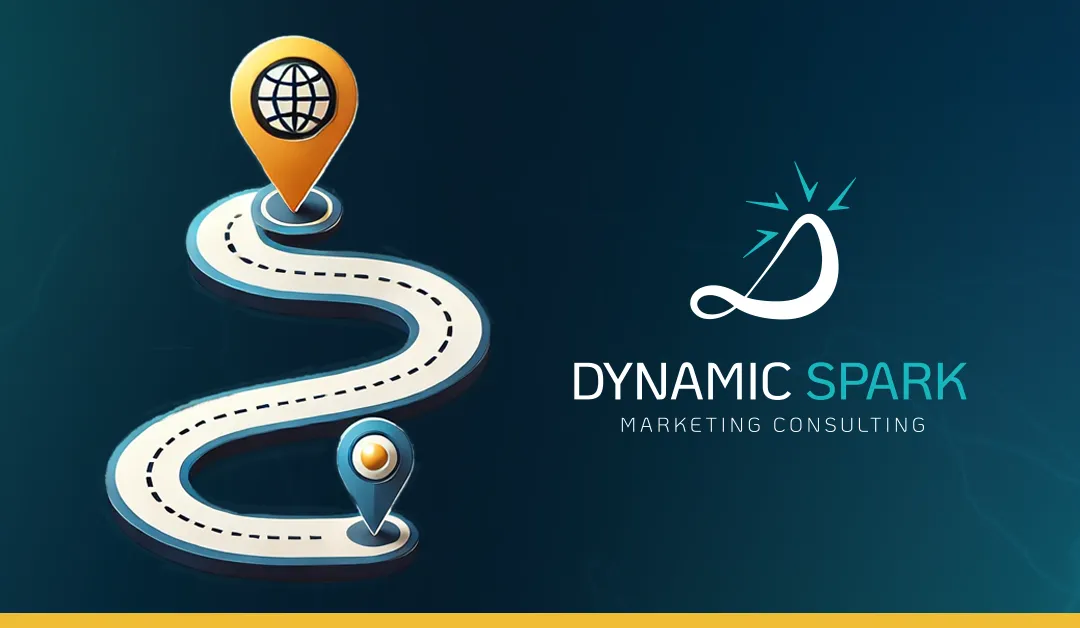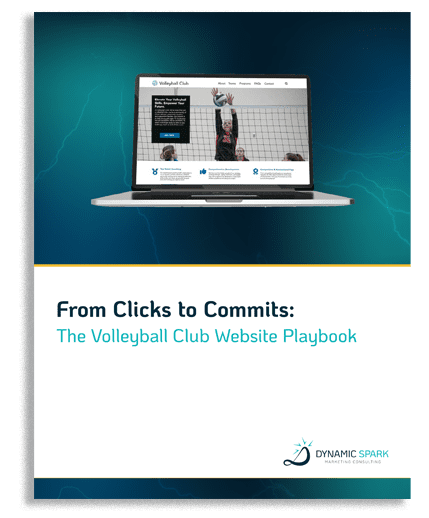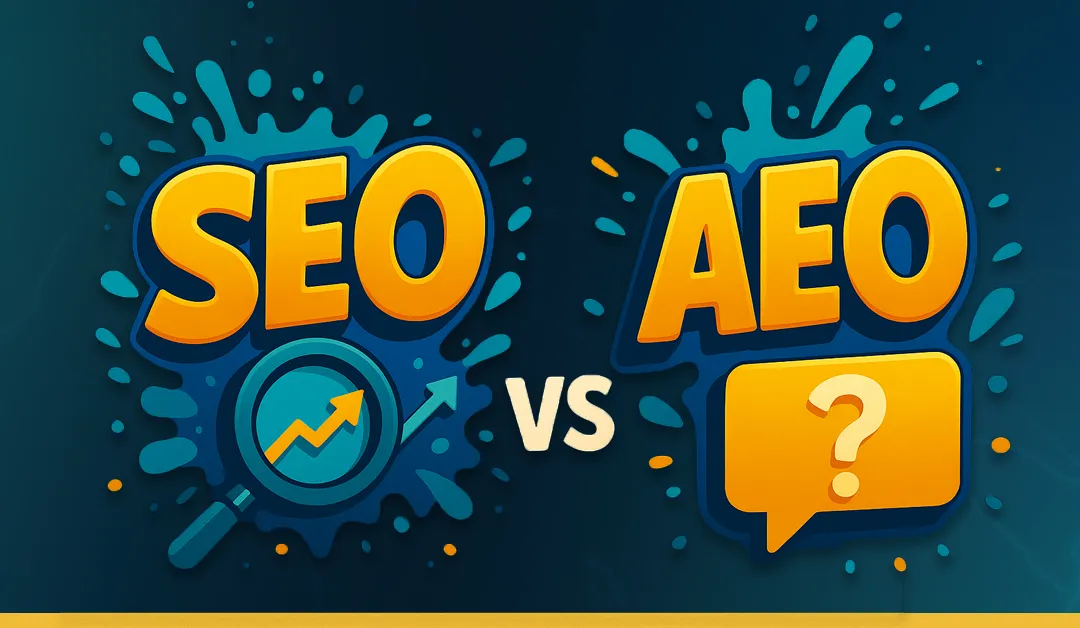
by Judah | Oct 24, 2025 | Business Strategy, Content Marketing Tips, Marketing, SEO & Online Visibility
If you are like me and have kids in elementary and middle school, you’ve been hearing the constant repeating of the numbers, “6-7”. Every generation has its thing. For my kids, it’s “6-7.” For me growing up, it was quoting movie lines from Tommy Boy or Happy Gilmore. But now, my kids have turned this nonsense number game into an art form. I can’t even say the number six without them firing back with “seven” and the hand gesture that goes with it. It is so cool and funny when my 10 and 12 yr old do it, but whenever I subtly mix it in to conversation, I get this blank stare from my daughter as if to say, “No, Dad, not cool.”

It’s gotten to a point where I’ve thought, do I embrace and capitalize on this trend by creating some fun and interesting “6-7” t-shirts?
The same impulse that drives kids to repeat viral memes is tempting business owners to jump on every marketing fad. I’ve caught myself doing it: chasing AI for AI’s sake, launching that hot new platform, or copying what someone else’s brand is doing. And it usually backfires.
So how do you spot which marketing trends are worth your time and which ones are just shiny distractions?
The Temptation of Trends
It’s easy to feel like you’re falling behind if you’re not experimenting with every new marketing tool. In fact, Semrush reports that 67% of marketers say they currently use AI for content marketing or SEO (pretty relevant statistic 😊). And according to HubSpot’s 2025 Marketing Trends data, AI tools for content creation and workflow automation are top investments.
But most small businesses don’t have the people, budget, or brand clarity to adopt every trend meaningfully. Blindly chasing fads can distort your budget, distract your team, and dilute your brand. That “must-do” trend might cost you much more than it returns.
When Chasing Trends Costs You Your Brand
Brand consistency matters. According to branding research by Fit Small Business, consistent branding across channels can increase revenue by up to 20%. If your business is switching voices, visuals, and platforms every few months chasing what’s new, you lose memorability.
Imagine your brand as a signature style; something people recognize instantly. If you keep overlaying every new trend, you lose your edge. Your brand becomes bland. When everyone’s chasing the same shiny thing, no one stands out.
Marketing Trends Worth Watching
Let’s call out a few trends that are worth considering, but only if they fit your business:
- AI-assisted content & automation — Marketers increasingly use AI tools to scale content creation and optimize workflows. CMSWire.com
- Visual storytelling & video-first content — Short-form video continues to dominate engagement. CMSWire.com
- Answer Engine Optimization (AEO) / generative search answers — Search engines are delivering answers, not just links. Some queries never result in a website click anymore. TechRadar
These trends are valid. But they should amplify your brand, not hijack it.
How to Evaluate a Trend Before You Dive In
Before you pour time or money into something new, run it through this Trend Test Checklist:
✅ Audience fit: Will this trend help reach your actual customers — not just impress marketers?
✅ Measurement clarity: Can you tie it back to leads, awareness, or conversions?
✅ Brand alignment: Does this trend blend with your brand voice, or does it force you to act like someone else?
✅ Data signals: Use Google Trends, analyze competitor adoption, and review preliminary metrics before full rollout.
✅ Complement vs. distract: Will this support your core marketing or steal resources from your foundational channels?
What to Do Instead
Stop chasing every bright new thing. Start with clarity:
- Define your brand story and positioning
- Invest in a website or audit that shows what’s working and what’s not
- Build foundational tools (email, FAQs, content pillars) before layering in trends
- Use trends as strategic amplifiers, not substitutes
The most lasting marketing trends? Consistency. Repetition. Authentic voice.
How do I know if a marketing trend fits my business?
Start by asking one simple question: Would this trend help me reach and serve my ideal customer better? If the answer is “I’m not sure,” it’s worth pausing. Use a quick test before diving in:
-
Audience Fit: Does your audience use this platform or format?
-
Brand Alignment: Does it reflect your voice and values, or does it make you sound like everyone else?
-
Sustainability: Can you realistically maintain it for 6+ months without stretching your team thin? Trends should amplify what’s already working, not replace it. If it feels like a full pivot, it’s probably a distraction.
What happens when businesses chase too many marketing trends at once?
Think of your marketing like compound interest — it grows through consistent deposits. Jumping between trends resets your momentum every time. The fallout usually looks like this:
-
Inconsistent messaging: Customers can’t tell who you are or what you stand for.
-
Scattered focus: Your time and money get split across half-baked efforts.
-
Weaker trust: Audiences start tuning you out because nothing feels steady.
The cure isn’t to avoid trends completely, but to build a solid foundation (website, email, SEO) first, then layer trends that support your story.
What marketing trends in 2025 are worth paying attention to?
Not all trends are gimmicks. Some represent real shifts in how people find and engage with brands. A few to watch include:
-
AI-assisted content creation and automation: Helpful for efficiency, but it only works when you personalize it with human insight.
-
Video-first storytelling: Short-form video remains powerful for connection, especially if you show your process or people behind the brand.
-
Generative search and AEO (Answer Engine Optimization): Search engines are giving users direct answers now, so your content needs clear, conversational phrasing that matches what people ask.
The key is to adopt strategically, not reactively. Every trend should pass your “brand filter” first.
How can I stay up to date with trends while keeping my marketing consistent?
Consistency isn’t the enemy of creativity; it’s the framework that makes creativity believable. To stay consistent:
- Document your brand voice — What you sound like, what you don’t, and your core story.
- Create content pillars — 3–5 key themes you talk about regularly.
- Batch plan — Dedicate specific weeks or campaigns for trend testing rather than reacting weekly.
- Review quarterly — Look at data, audience feedback, and performance before deciding what to keep.
When you have a clear rhythm, trends become tools you can plug in, not disruptions you chase.
How can a website audit and strategy call help me choose the right marketing trends?
A website audit gives you a clear picture of how your current marketing is performing — things like SEO health, site speed, messaging clarity, and conversion flow. Pairing that with a strategy call turns insight into action. Together, we’ll:
-
Identify which channels or trends are driving your traffic and leads.
-
Uncover where your messaging or brand story might be confusing visitors.
-
Find opportunities to improve SEO so your website shows up better in search results.
-
Map out practical next steps based on data, not hype.
It’s the difference between guessing what works and knowing what works. For most small businesses, that clarity alone is worth more than any hot new marketing trick.
Want Clarity Before Chasing the Next Fad?
If you’re tired of trying every new marketing gimmick without seeing real results, start with clarity.
I’m offering a free Website Audit to help you see what’s working, what’s not, and where your site might be holding you back.
From there, you can book a discounted Strategy Call (for a limited time) where we’ll walk through your results, uncover growth opportunities, and outline a focused next step for your business.
No fluff. No pressure. Just clear insights and a plan you can trust.

by Judah | Sep 5, 2025 | Club Growth Strategies, Marketing, SEO & Online Visibility, Small Business Growth, Volleyball Marketing, Web Design & Development, Website Tips for Clubs
A Parent’s Frustration Turned Into a Passion
When my daughter first told me she wanted to play club volleyball, I thought finding the right club would be simple. I’d been around volleyball my whole life, playing through high school, competing for three years in college, and even coaching for a season.
Her interest in volleyball really took off after watching the University of Wisconsin women’s volleyball team win the national championship. She was eager to play, and I was excited to help her start.
But as a parent, searching for a club was harder than I expected. Many club websites didn’t have enough information to help me compare programs. I struggled to find basic details like schedules, costs, and levels of commitment. Eventually, I signed her up for a club mostly based on location. I didn’t understand how team offers worked and missed the response window for her placement, which shaped her entire first season.
Even after coaching club for a year, I found myself asking the same questions other parents were asking me. If I was still confused, I knew parents who were brand new to the club world must be feeling the same frustration.
That’s when I realized volleyball clubs have an opportunity. Parents weren’t frustrated with the programs themselves, they were frustrated because they couldn’t get the details they needed to make informed decisions.
With over a decade of experience in marketing and website design, I decided to start Dynamic Spark to help clubs communicate better, save time, and attract the right athletes and families.
Why Websites Matter More Than You Think
Many club directors see their websites as just one of the tools they need to manage their club, but often they aren’t sure how to use them effectively. But your website is more than a digital brochure. It’s your 24/7 recruiter, communications hub, and first impression.
When a parent searches “volleyball club near me,” they aren’t just looking for dates and pricing. They are evaluating your professionalism, organization, and values. A polished, easy-to-navigate website builds trust before you ever talk to them. A confusing or outdated site, even if your program is outstanding, can unintentionally send the wrong message.
Parents are also making comparisons. When a club’s website is informative and easy to navigate, it naturally builds credibility. Your website is often the deciding factor in whether a parent reaches out or moves on.
According to a BusinessDasher’s 42+ Statistics About Websites Businesses Must Know for 2024, 75% of users judge a company’s credibility based on its website design. That means parents are forming opinions about your club within seconds of landing on your site.
Many directors worry about investing in a better site because it feels like another task on an already long to-do list. Others wonder if the expense is worth the investment, or they aren’t fully aware of technical issues that may be holding their site back from showing up in search results or competing with other clubs in the area. But your website is the one tool that works around the clock. It’s where families start their journey, and it’s often where they decide whether your club feels like the right fit.
A Strategic Approach to Volleyball Club Websites
The good news is, you don’t need a massive overhaul to see a big difference. By focusing on clarity, organization, and trust, your club can stand out without overwhelming you or your budget. Below are essentials every volleyball club website needs to educate parents, save time, and help you recruit the athletes who are the best fit for your program.
Essentials Every Volleyball Club Website Needs
- Your Club’s “Why” Front and Center
Parents want to know what your club stands for. Beyond logistics, what’s your philosophy? Why should they trust your program to invest in their child’s growth? Sharing your story, values, and coaching approach creates a connection.
- Clear Program and Tryout Information
Parents should know exactly what their athletes are trying out for, what teams or levels you offer, and what the season commitment looks like. Include details about practice schedules, season length, and tournament participation.
- Practice and Competition Schedules
It’s not just about practices. Families need to plan ahead, so sharing competition dates or at least a clear timeframe is key. If you offer strength and conditioning or off-season training, list that too.
- Easy-to-Find Registration
Whether it’s tryouts, clinics, or private lessons, registration should be a single click away from your homepage. Use buttons with clear labels like “Register Now” or “Tryout Info.”
- Coach Bios and Staff Information
Parents want to know who will be working with their kids. Adding coach bios, experience, and even photos helps build trust and gives your club a personal touch.
- Visuals That Reflect Your Brand
High-quality images of your athletes, events, and staff create a professional impression. Make sure all images are optimized for speed and include descriptive alt text for accessibility and SEO.
- FAQs to Save Time
Think about the top 10 questions you get asked every season. How much does it cost? Where are practices? How do I know what team my athlete should try out for? Adding an FAQ section reduces back-and-forth communication and positions your club as organized and approachable.
How a Good Website Saves You Hours
A well-built volleyball club website is more than just a recruiting tool. It’s your communication hub that works around the clock. Parents can get answers to their questions, explore your programs, and decide if your club is the right fit before they ever send an email.
Directors often spend hours responding to repetitive questions. A strategic site reduces the workload by proactively answering those questions. When parents are well-informed, they are more confident, and your staff can focus on coaching and operations rather than endless email threads.
Think of your website as an investment in your time. A clear and organized site will free you up to focus on what matters most: growing your program and developing athletes.
Common Pitfalls That Drive Parents Away
Even small missteps on your website can push families toward another club. Here are a few to watch for:
-
Slow page load times due to oversized or rotating images
-
Confusing navigation that makes parents dig for basic details
-
Brief or missing information that forces families to send extra emails
-
Broken links or outdated pages that create doubt about your organization
-
Lack of trust-building elements like coach bios, testimonials, or program descriptions
A simple audit of your site can reveal these issues quickly, and many fixes are inexpensive or free.
Parents are not just choosing a club. They are choosing a community for their child. Your website is often their first interaction with your program. By making it clear, accessible, and welcoming, you are already building trust and setting your club apart.
Whether you choose to tackle these updates yourself or get expert support, a strong website is one of the most effective tools to grow your club. It is more than a digital brochure. It is your silent recruiter, your communications hub, and your 24/7 representative.
Free Resource for Volleyball Club Directors
If you’d like practical tips you can apply right away, I’ve created a free guide: From Clicks to Commits: The Volleyball Club Website Playbook.
This playbook includes short, actionable steps to help your website:
-
Clearly communicate who you are and what you offer
-
Show up in search results when parents are researching clubs
-
Build credibility and trust with families deciding where to commit
-
Highlight what makes your club different from the rest
It’s built specifically for volleyball clubs, and it’s completely free.
Take the next step today and grab your copy of the playbook. It might be the easiest win you make for your club this season.

by Judah | May 29, 2025 | Email Marketing & Automation, Lead Generation & Nurturing, SEO & Online Visibility, Small Business Growth, Web Design & Development
Building a website without a growth plan is like hitting the road on a family trip with your kids with: no snacks, no entertainment, no mobile data, and of course, the check engine light flicks on halfway through hour one. You’ll get somewhere… but not without chaos, complaints, and maybe a little emotional damage.
So, What Is a Website Growth Plan?
A website growth plan is a strategic roadmap designed to grow your online presence and generate leads. It goes beyond “make it look good” and into “make it work hard.” It combines content, SEO, lead capture, email marketing, and more to align your website with your business goals (Note: If these terms are a little foreign to you, visit the Marketing & Website Terms Made Simple page).
Think of it as what Walter White was to Breaking Bad, methodical, precise, a little gritty, and highly calculated (minus the moral decay).
Here’s what a typical website growth plan might include:
-
Location-Specific SEO Pages: These help you show up when someone types “[your service] near me” and doesn’t want to scroll past Yelp.
-
Keyword Research & Organic SEO: Instead of guessing what your customers search for, we research it and bake those terms right into your content.
-
Strategic FAQs: Because if people keep asking, your site should be answering.
-
Content Marketing via Blogs: Useful, helpful, and optimized for search engines.
-
Lead Magnets: Irresistible downloads or freebies that get visitors to say, “Yeah, I’ll trade my email for that.”
-
Email Follow-Up Series: Think of this as the nurturing sequence that gently guides leads toward working with you.
-
Monthly E-Newsletter: Ongoing education that keeps your brand top of mind and helps potential customers without being pushy.
Learn more about what is included in our Website Growth plans.
Why I’m Building My Own Growth Plan (and What I’ve Learned)
After a corporate downsizing, I took my 10+ years of experience in corporate marketing and stepped into building my own business. I thought my freelance website was a head start, but I quickly realized I had to go deeper and create something that truly aligned with my goals and the audience I wanted to reach.
I’m currently developing that strategy, creating content, crafting lead magnets, planning email series, and writing blogs just like this one to support other small businesses navigating the same waters.
This isn’t just theory. It’s the very approach I’m using to grow Dynamic Spark, and it’s the kind of strategy I can help you implement too.
What Happens If You Don’t Have a Website Growth Plan?
You might still have a website that looks decent. You might get a few inquiries. But you’re probably also:
-
Missing out on search traffic.
-
Not capturing leads.
-
Wasting time with dead-end marketing.
-
Feeling like you’re throwing digital spaghetti at the wall to see what sticks.
That’s where a strategy saves you.
Your website should be working around the clock to get results. But without the right intel, it’s just shouting into the void while the real action happens somewhere else. In short: it starts doing what you actually built it for.
Ready to Build Your Growth Plan?
If your website is coasting and you’re ready for it to start pulling its weight, let’s get moving. Start by filling out this quick questionnaire and let’s figure out how to make your site do more than just sit there looking pretty.
Fill out the Website Questionnaire
It’s fast. It’s strategic. And it’s one step closer to clarity.

by Judah | Mar 26, 2025 | Digital Marketing Strategies, Lead Generation & Nurturing, SEO & Online Visibility, Small Business Growth, Web Design & Development, Website Maintenance & Optimization
So, you’re thinking about building your own website. How hard can it be? It’s like cutting your own hair—you can do it, but you might not want to show anyone the results.
DIY website builders promise you’ll have a site up in minutes. Just drag, drop, and poof—you’re the next digital entrepreneur. But here’s the problem: looking “done” and looking professional are two very different things.
Meanwhile, a professionally designed website isn’t just there to look pretty. It’s a 24/7 sales rep, working to convert visitors into customers while you sleep. So, let’s break down the real difference between a DIY site and one built by someone who actually knows what they’re doing.
1. First Impressions: Is Your Website Scaring Away Customers?
Your website has about 3 seconds to impress visitors before they leave faster than a cat avoiding bath time.
DIY Website Struggles:
❌ Generic templates that make your site blend into a sea of mediocrity
❌ Confusing layouts where visitors have no clue where to click
❌ Font choices that scream “designed by my cousin who took a graphic design class in 2008.”
What a Pro Designer Does:
✔ Creates a custom, on-brand design that makes you look legit
✔ Optimizes layout and visuals to keep visitors engaged
✔ Designs for mobile first (because over 60% of your traffic is coming from phones)
The Hidden Cost of DIY Websites: If your site looks unprofessional, people assume your business is, too. That means lost trust, lost credibility, and lost sales.
2. SEO: Can Google Even Find Your Site, Bro?
If your website exists but isn’t ranking on Google, does it even exist?
DIY SEO Nightmares:
🔍 Slow loading speeds—Google hates slow sites, and so does everyone else
🔍 No keyword strategy—just hoping people “stumble upon” your site
🔍 No mobile optimization—Fun fact: Google ranks mobile-friendly sites higher
What a Pro Designer Does:
✔ Improves page speed so visitors (and Google) stick around
✔ Optimizes for the right keywords so you actually show up in search results
✔ Builds a mobile-first site to help improve user-experience
Hidden Cost of DIY: If Google doesn’t rank your site, your competitors are stealing your traffic.
3. User Experience: Is Your Site Annoying People?
Nothing says untrustworthy business like a broken contact form or a checkout page that mysteriously deletes everything right before purchase.
DIY Website Fails:
🤦 Links that go nowhere or worse, to an error page
🤦 No clear call-to-action so visitors leave without taking action
🤦 Navigation so confusing that users need a map and compass
What a Pro Designer Does:
✔ Ensures everything actually works (crazy concept, right?)
✔ Guides visitors toward taking action (like booking a call or buying a product)
✔ Makes navigation smooth & intuitive (so people don’t rage-quit)
Hidden Cost of DIY: If users can’t easily navigate your site, they’ll leave. And guess what? They’re not coming back.
4. Security & Maintenance: Hackers Love DIY Websites
Think hackers only go after big companies? False. Small business websites get hacked every day because they often lack basic security.
DIY Website Weaknesses:
🔓 No regular updates or security patches
🔓 Weak protection against malware and cyberattacks
🔓 No backups—so if something breaks, good luck
What a Pro Designer Does:
✔ Sets up proper security measures to keep your site safe
✔ Monitors & updates regularly with a Website Support Plan so you don’t have to
✔ Ensures your site gets backed up—because disasters happen
Hidden Cost of DIY: If your site gets hacked, you could lose business, credibility, and SEO rankings overnight.
5. Lead Generation: Is Your Website Just Sitting There?
Your website shouldn’t just sit around looking pretty—it should be bringing in leads and sales.
DIY Lead Gen Fails:
❌ No clear call to action—so visitors leave without converting
❌ No trust-building elements—so visitors lack reassurance you’re legit
❌ No lead capture system—so you’re missing out on potential customers
What a Pro Designer Does:
✔ Creates clear, action-driven pages that turn visitors into buyers
✔ Uses social proof & credibility markers like testimonials and case studies
✔ Builds in lead capture tools to grow your email list & customer base
Hidden Cost of DIY: If your website isn’t converting visitors, you’re leaving money on the table.
The Real Cost of a DIY Website vs. a Professional Site
Let’s break it down:
💻 DIY Website:
✔ Cheaper upfront (woohoo!)
✔ You get full control (even if you don’t know what you’re doing)
❌ Looks generic
❌ Ranks poorly on Google
❌ Frustrates visitors (who leave without buying)
❌ Vulnerable to security risks
❌ Ends up costing you more in lost sales
🚀 Professional Website:
❌ Costs more upfront
❌ Limited control on how to build or make changes
✔ Designed to convert visitors into customers
✔ SEO-friendly (so people actually find you)
✔ Loads fast, works seamlessly, and builds trust
✔ Saves you time, stress, and lost revenue
✔ Is an investment in your business growth
The Verdict: DIY or Pro?
You can build your own website—just like you can fix your own plumbing. But when your DIY project ends up costing you more time, money, and customers… was it really worth it?
If you’re ready to invest in a website that actually works, let’s talk.
Contact us today!
Or… you could spend the next three weekends Googling “why does my website look weird on mobile?”
Your call. 😉







